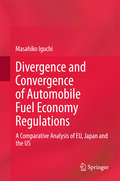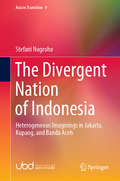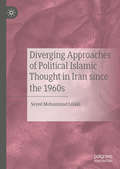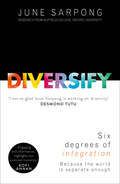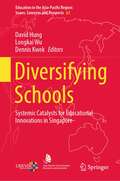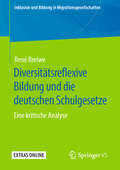- Table View
- List View
District Leaders: A Political Ethnography
by Rachel SadyThis book highlights the roles played by a selection of people who make up the lowest layer of elected party office holders and are closest to voters. It analyses three themes that emerge from ethnographic data: political process participation, the role of parties; and parapolitical factionalism.
District Leaders: A Political Ethnography
by Rachel SadyThis book highlights the roles played by a selection of people who make up the lowest layer of elected party office holders and are closest to voters. It analyses three themes that emerge from ethnographic data: political process participation, the role of parties; and parapolitical factionalism.
Disturbed Behavior in the Elderly
by A. G. Awad Henry Durost H. M. Rosemary MeierDisturbed Behavior in the Elderly provides information pertinent to the needs of those giving care as well as of the elderly themselves. This book presents relevant topics of contemporary psychiatric importance.Organized into four parts encompassing 11 chapters, this book begins with an overview of the clinical, administrative, and interpersonal problems posed by the elderly patient with disturbed behavior. This text then examines the rational management of disturbing behavior among the elderly in health care and other residential settings. Other chapters consider the use of medications and psychotropic drugs in old age. This book discusses as well the great value of drug therapy in alleviating the sufferings of the elderly and helping them restore the equilibrium that has been disturbed by aging, physical disability, and shrinking socio-economic network around them. The final chapter deals with staff burnout, job stress, and low morale in dealing with the elderly.This book is a valuable resource for geriatric psychiatrists and caregivers.
Disunion within the Union: The Uniate Church And The Partitions Of Poland (Harvard papers in ukrainian studies #15)
by Larry WolffA leading historian radically revises our understanding of the fate of Jews under the Vichy regime. Winner of the Prix d’histoire de la justice.Thousands of naturalized French men and women had their citizenship revoked by the Vichy government during the Second World War. Once denaturalized, these men and women, mostly Jews who were later sent to concentration camps, ceased being French on official records and walked off the pages of history. As a result, we have for decades severely underestimated the number of French Jews murdered by Nazis during the Holocaust. In Denaturalized, Claire Zalc unearths this tragic record and rewrites World War II history.At its core, this is a detective story. How do we trace a citizen made alien by the law? How do we solve a murder when the body has vanished? Faced with the absence of straightforward evidence, Zalc turned to the original naturalization papers in order to uncover how denaturalization later occurred. She discovered that, in many cases, the very officials who granted citizenship to foreigners before 1940 were the ones who retracted it under Vichy rule.The idea of citizenship has always existed alongside the threat of its revocation, and this is especially true for those who are naturalized citizens of a modern state. At a time when the status of millions of naturalized citizens in the United States and around the world is under greater scrutiny, Denaturalized turns our attention to the precariousness of the naturalized experience—the darkness that can befall those who suddenly find themselves legally cast out.
The Ditch: A Novel
by Herman KochIn the new novel by the author of the world-wide bestseller The Dinner, Herman Koch turns his brilliantly acid and forensic eye to the green-eyed monster: the all-too human emotion of jealousy.Robert Walter, the popular mayor of Amsterdam, begins to suspect that his wife is cheating on him with one of his aldermen. Though he is happily married, he has always wondered why his wife, born and raised in a distant country, chose him above his brilliant and good-looking physicist friend Bernhard.When, to add to his concerns, he becomes the subject of accusations relating to his past, at the same time his parents force him to address issues of their mortality. This apparently stable and successful man begins to become consumed by fantasies of jealousy and paranoia.Or does he? Is Robert finally beginning to see the world – and his life – as they are, for the first time?As page-turning and gripping as The Dinner, Koch’s new novel confronts us with questions that haunt us all. Who can we trust? Do we deserve our lives or owe them only to luck? And is it when we are depressed that we see the world most clearly?
Divergence and Convergence of Automobile Fuel Economy Regulations: A Comparative Analysis of EU, Japan and the US
by Masahiko IguchiThis book reveals the mechanisms underlying the convergence of car fuel economy regulations in Europe, Japan and the US by drawing upon a constructivist theory of International Relations and law that focuses on business competition and environmental regulations. It offers new understanding of the topic of cars and an issue of climate change, discussing the emerging phenomenon of convergence of fuel economy regulations; addressing the role of business actors in pushing for climate change action; proposing the new model of agency with and beyond states; and providing insightful case studies from Europe, Japan and the US.The opening chapter reviews the automobile industry and global climate change, providing a background for the discussion to follow. Chapter 2, Business Actors and Global Environmental Governance, grounds the discussion in the field of environmental governance. The third chapter is a case study examining the construction and timing of the European Union's climate policies for automobile CO2 emissions, discussing the underlying factors and the actors influencing the policies. The following chapter argues that Japan adopted its stringent fuel economy regulations primarily because of industry competitiveness, motivated by stringent environmental regulations in export markets and encouraged by a tradition of ‘co-regulation’ and ‘corporatism’ to enhance the regulations. Chapter 5 asks why the US, the first country to introduce fuel economy regulations, spent two decades in regulatory stagnation, and discusses how recent US fuel economy regulations came to converge with Japanese and European standards.Chapter 6 compares, contrasts and analyzes fuel economy regulations among the three case studies and identifies policy implications for the future climate governance for 2015 and beyond. The final chapter explores applicability of the ‘agency with and beyond the state’ model to other sectors and to climate governance as a whole.
Divergent Democracy: How Policy Positions Came to Dominate Party Competition (Princeton Studies in American Politics #204)
by Katherine KrimmelAn innovative examination of the shift by American political parties toward issue-based differentiationRecent Democratic and Republican party platforms display clear differences on such issues as abortion, LGBTQ+ rights, gun control, and the environment. These distinctions reflect a programmatic party system—that is, one in which policy positions serve as a key basis of electoral competition. Yet party politics were not always so issue-oriented; the rise of policy positions as the dominant marker of party appeal occurred largely over the last fifty years. In Divergent Democracy, Katherine Krimmel examines this transformation of the American party system, using innovative machine learning techniques to develop and present the first measure of party differentiation on issues since Democrats and Republicans began competing with each other in 1856.Why did the shift to issue-based party competition take more than a century to materialize? Krimmel offers a groundbreaking theory, focusing on what aids and constrains parties&’ abilities to do the difficult, conflict-ridden work of developing issue positions. She argues that clientelistic subnational party organizations, promising material support or jobs in return for votes, long impeded programmatic partisanship while the growth of national party organizations facilitated it. Moreover, institutions and agents of racial oppression extended the life of nonprogrammatic practices, as they attempted to shield discriminatory laws and institutions from interparty competition. Following the civil rights revolution of the 1960s, space opened for programmatic competition to grow.Using both quantitative and qualitative tools, Krimmel offers a vital view of the foundations of today&’s issue-based party competition and its alternatives.
Divergent Democracy: How Policy Positions Came to Dominate Party Competition (Princeton Studies in American Politics #204)
by Katherine KrimmelAn innovative examination of the shift by American political parties toward issue-based differentiationRecent Democratic and Republican party platforms display clear differences on such issues as abortion, LGBTQ+ rights, gun control, and the environment. These distinctions reflect a programmatic party system—that is, one in which policy positions serve as a key basis of electoral competition. Yet party politics were not always so issue-oriented; the rise of policy positions as the dominant marker of party appeal occurred largely over the last fifty years. In Divergent Democracy, Katherine Krimmel examines this transformation of the American party system, using innovative machine learning techniques to develop and present the first measure of party differentiation on issues since Democrats and Republicans began competing with each other in 1856.Why did the shift to issue-based party competition take more than a century to materialize? Krimmel offers a groundbreaking theory, focusing on what aids and constrains parties&’ abilities to do the difficult, conflict-ridden work of developing issue positions. She argues that clientelistic subnational party organizations, promising material support or jobs in return for votes, long impeded programmatic partisanship while the growth of national party organizations facilitated it. Moreover, institutions and agents of racial oppression extended the life of nonprogrammatic practices, as they attempted to shield discriminatory laws and institutions from interparty competition. Following the civil rights revolution of the 1960s, space opened for programmatic competition to grow.Using both quantitative and qualitative tools, Krimmel offers a vital view of the foundations of today&’s issue-based party competition and its alternatives.
The Divergent Nation of Indonesia: Heterogeneous Imaginings in Jakarta, Kupang, and Banda Aceh (Asia in Transition #9)
by Stefani NugrohoThis book explores how Indonesia is imagined differently by young people in the three cities of Jakarta, Kupang and Banda Aceh. Throughout the course of Indonesia’s colonial and postcolonial history, Jakarta, the capital, has always occupied a central position, while Kupang in East Nusa Tenggara and Banda Aceh in Nanggroe Aceh Darussalam are located at the peripheries. The book analyses the convergences and divergences in how the country is perceived from these different vantage points, and the implications for Indonesia, also providing a new perspective to the classic and contemporary theories of the nation. By examining the heterogeneity of the imaginings of the nation ‘from below’, it moves away from the tendency to focus on the homogeneity of the nation, found in the classic theories such as Anderson’s and Gellner’s, as well as in more recent theories on every day and banal nationalism. Using the tenets of standpoint theory and Laclau and Mouffe’s theory of hegemony, the nation is acknowledged as an empty signifier that means different things depending on the positionality of the perceiving subject. The work appeals to scholars of nation studies and Asian and Indonesian studies, as well those interested in the empirical grounding of poststructuralist theories.
Divergent Paths in Post-Communist Transformation: Capitalism for All or Capitalism for the Few? (Studies in Economic Transition)
by O. HavrylyshynThe most comprehensive and up-to-date analysis of the successes and failures of 27 countries post-communism transformation. Looking at life after the fall of the Berlin wall in 1989, the book examines and contrasts why some countries have virtually completed their transformation to a liberal polity and economy, while others lag behind.
Diverging Approaches of Political Islamic Thought in Iran since the 1960s
by Seyed Mohammad LolakiThis book argues that Political Islam in the Iranian context evolved into three main schools of thought during the 1960s and 1970s: Jurisprudential Islam led by Ayatollah Khomeini, Leftist Islam led by Shariati, and Liberal Islam led by Bazargan. Despite the fact that all schools seek an Islamic state, their chosen methods and philosophical approaches diverge considerably. The synthesis of these three contrasting socio-political views is structured here to provide a coherent interpretation by means of ongoing comparison. This method has so far not been presented in academic studies within the field of Political Islam.Furthermore, this book provides a critical analysis of the aforementioned ‘Political Islam’ schools in Iran, their similarities and differences, relative success or failure, their contribution to the revolution of 1979 and how they have evolved from the pre-revolution era to the present.
Diverging Capitalisms: Britain, the City of London and Europe (Building a Sustainable Political Economy: SPERI Research & Policy)
by Colin Hay Daniel BaileyThis book analyses the changing nature of the British economy and the consequences of Brexit upon its place within the European economic space. The overhang from the global financial crisis, the Eurozone crisis, the political negotiation of prolonged economic downturn and now the spectre of ‘Brexit’ provide the backdrop for various forms of capitalist restructuring designed to restore competitiveness and prosperity. This re-structuring has clear implications for existing European growth models, the structural imbalances and inequalities which characterise the British economy, the fortunes of the City of London and competing financial districts internationally, and the prospective strategies of progressive politics in this context. Adopting a broadly critical political economy lens – which gives analytical weight to the relationship between economic and political dynamics – the book will draw on the research of eminent scholars to assess divergence in the foundations of economic competitiveness and their social repercussions.
Diverging Destinies: The Japanese Case (SpringerBriefs in Population Studies)
by James M. Raymo Miho IwasawaThe overarching objective of this book is to summarize, extend, and update previous research on educational differences in family behavior in Japan. This is the first comprehensive treatment of the subject and the first to evaluate family differentials in Japan in the context of ideas articulated in research on “diverging destinies” and “patterns of disadvantage” as part of the second demographic transition. Much of the previous work in this area has been conducted by the authors (Raymo and Iwasawa), and the longer format of this book allows us to reexamine a wide range of family outcomes using newer data and to provide a thorough and systematic evaluation. The text uses multiple sources of data that cover a period of rapid family change (1970s through 2010s) to describe trends in educational differences in a wide range of family behaviors linked to the well-being of both parents and children. Descriptive analyses provide an overview of period and cohort trends in educational differences in age at first marriage, assortative mating, cohabitation, bridal pregnancy, divorce, remarriage, age at first birth, unintended childbearing, single motherhood, maternal employment, and family-related attitudes. Multivariate analyses provide insights into the processes underlying observed educational differences in family behavior. Patterns of educational differences in family behavior in Japan are evaluated with reference to findings from related research in the United States and other low-fertility Western societies.
Diverging Parties: Social Change, Realignment, And Party Polarization
by Jeff StonecashExplores how redistricting, demographic shifts, and political polarization are impacting legislation and voting behavior in the US Congress. . Party polarization in the House of Representatives has increased in recent decades. Explaining this development has been difficult, given current interpretations of American elections. The dominant framework for interpreting elections has been to see them as candidate-centered, or individualistic. This framework may have seemed appropriate as a way to see elections during the 1970s and 1980s, when identification with parties declined and split-ticket voting increased. With increasing party differences, however, the presumptions that campaigns focus on candidates separate from parties, and that voters are less partisan in their voting, do not provide a satisfactory framework for understanding our current situation. This proposed book explains the emergence of party polarization by focusing on how the constituencies of House districts affect partisan outcomes and the subsequent voting behavior of House members. This proposed analysis is premised on the simple argument that members are elected from districts, and an explanation of polarization must begin with districts. The origins of polarization lie in the realignment of the electoral bases of the parties, and the shifting demographic composition of America. Liberal voting is more likely among members from urban, lower-income, largely non-white districts. Conservative voting is more likely among members from higher-income, largely white districts. Realignment has resulted in Democrats representing urban, lower-income, heavily non-white districts, while Republicans are more likely to come from suburban-rural, more affluent, white districts. Perhaps most important, the percentage of districts with a substantial proportion of non-whites is steadily increasing in the United States. The analysis will focus primarily on changes since the 1960s.
Diverging Parties: Social Change, Realignment, And Party Polarization
by Jeff StonecashExplores how redistricting, demographic shifts, and political polarization are impacting legislation and voting behavior in the US Congress. . Party polarization in the House of Representatives has increased in recent decades. Explaining this development has been difficult, given current interpretations of American elections. The dominant framework for interpreting elections has been to see them as candidate-centered, or individualistic. This framework may have seemed appropriate as a way to see elections during the 1970s and 1980s, when identification with parties declined and split-ticket voting increased. With increasing party differences, however, the presumptions that campaigns focus on candidates separate from parties, and that voters are less partisan in their voting, do not provide a satisfactory framework for understanding our current situation. This proposed book explains the emergence of party polarization by focusing on how the constituencies of House districts affect partisan outcomes and the subsequent voting behavior of House members. This proposed analysis is premised on the simple argument that members are elected from districts, and an explanation of polarization must begin with districts. The origins of polarization lie in the realignment of the electoral bases of the parties, and the shifting demographic composition of America. Liberal voting is more likely among members from urban, lower-income, largely non-white districts. Conservative voting is more likely among members from higher-income, largely white districts. Realignment has resulted in Democrats representing urban, lower-income, heavily non-white districts, while Republicans are more likely to come from suburban-rural, more affluent, white districts. Perhaps most important, the percentage of districts with a substantial proportion of non-whites is steadily increasing in the United States. The analysis will focus primarily on changes since the 1960s.
The Diverse Facets of Corruption in Sierra Leone
by Ina Kubbe Emmanuel Saffa AbdulaiThis edited volume delves into Sierra Leone’s complex post-conflict landscape. It posits that the nation’s path to peace and stability hinges on robust anticorruption measures. The chapters explore Sierra Leoneans’ unique perception of corruption, reflecting its political, economic, legal and socio-cultural dimensions. Moving away from mere theoretical abstraction, the book pulls together fascinating practical discussions on the success and challenges of anti-corruption tools used in Sierra Leone. Approaches used to explain corruption in this postwar fragile democratic country include issues like non-conviction-based asset recovery and how it works; unexplained wealth exposes lifestyle offences, accountability of the judiciary and how judicial institutions can become a predator; the role of the media in the fight against corruption; the part of culture and history in engraining corruption; patrimonialism as an explanation of corruption; ad social norms and sociological exposition to explain corruption.
Diverse Nations: Explorations in the History of Racial and Ethnic Pluralism (United States in the World)
by George M. FredricksonOne of the world's leading historians of race relations, George Fredrickson in his newest book probes the history of racial and ethnic diversity in the United States and other parts of the world. Diverse Nations explores recent interpretations of slavery and race relations in the United States and introduces comparative perspectives on Europe, South Africa, and Brazil. Notably, the book features groundbreaking work comparing ethnoracial pluralism in France and the United States. In contrast to the similarities of race relations in the United States and South Africa, which both drew rigid domestic color lines, the United States and France have historically diverged greatly in their approaches to racial difference. Yet both are influenced by a common heritage of revolutionary republicanism, extensive immigration, and cultural pluralism. Fredrickson's rich comparisons provide stimulating new insights into the continuing impacts of slavery and beliefs about race upon our increasingly pluralistic societies.
Diverse Nations: Explorations in the History of Racial and Ethnic Pluralism (United States in the World)
by George M. FredricksonOne of the world's leading historians of race relations, George Fredrickson in his newest book probes the history of racial and ethnic diversity in the United States and other parts of the world. Diverse Nations explores recent interpretations of slavery and race relations in the United States and introduces comparative perspectives on Europe, South Africa, and Brazil. Notably, the book features groundbreaking work comparing ethnoracial pluralism in France and the United States. In contrast to the similarities of race relations in the United States and South Africa, which both drew rigid domestic color lines, the United States and France have historically diverged greatly in their approaches to racial difference. Yet both are influenced by a common heritage of revolutionary republicanism, extensive immigration, and cultural pluralism. Fredrickson's rich comparisons provide stimulating new insights into the continuing impacts of slavery and beliefs about race upon our increasingly pluralistic societies.
Diversify: An award-winning guide to why inclusion is better for everyone
by June Sarpong‘A handbook for these troubled times’ Psychologies Magazine’Engaging and informative … highlights our common humanity’ Kofi Annan‘A passionately written polemic’ You Magazine The truth is, INCLUSION is better for EVERYONE.
Diversifying Schools: Systemic Catalysts for Educational Innovations in Singapore (Education in the Asia-Pacific Region: Issues, Concerns and Prospects #61)
by David Hung Longkai Wu Dennis KwekThis book discusses the strategies that the Singapore Education System has embarked to encourage school change and innovations. It documents the change journey of Specialized Schools and Future Schools in Singapore with a view to understand the key tenets that enable school wide change and reform. The intents for change and reform are to anchor the education system to the basic foundations and principles of education and yet enable the system as a whole to be malleable to change and globalization. It shows how Singapore enables diversity within a structured environment through innovations in Specialized and Future Schools, and highlights the systemic rationale behind various efforts in Specialized and Future Schools and the kinds of adaptations schools have made to leverage structures and make adjustments for their contexts.
Diversionary War: Domestic Unrest and International Conflict
by Amy OakesThe very existence of diversionary wars is hotly contested in the press and among political scientists. Yet no book has so far tackled the key questions of whether leaders deliberately provoke conflicts abroad to distract the public from problems at home, or whether such gambles offer a more effective response to domestic discontent than appeasing opposition groups with political or economic concessions. Diversionary War addresses these questions by reinterpreting key historical examples of diversionary war—such as Argentina's 1982 Falklands Islands invasion and U.S. President James Buchanan's decision to send troops to Mormon Utah in 1857. It breaks new ground by demonstrating that the use of diversionary tactics is, at best, an ineffectual strategy for managing civil unrest, and draws important conclusions for policymakers—identifying several new, and sometimes counterintuitive, avenues by which embattled states can be pushed toward adopting alternative political, social, or economic strategies for managing domestic unrest.
Diversität und Architektur: Über migrantisch initiierte Architektur in Deutschland (Architekturen #55)
by Anna Marijke WeberMigrantisch initiierte Architektur findet sich auch in profanen Lebensbereichen unserer Gesellschaft. Anna Marijke Weber untersucht auf Basis einer längerfristigen und vergleichenden Perspektive exemplarisch drei Beispiele: ein Eiscafé, eine Teestube und eine Shishabar. Ihre empirisch dichte zeichnerische und textliche Betrachtung wird von ausgewählten Arbeiten aus Architekturtypologie und Kulturwissenschaften gerahmt, die sie kritisch liest und miteinander ins Gespräch bringt, um ein angemessenes Verstehenskonzept zu definieren. Im Zentrum stehen dabei Entwurfsprozesse, räumliche Entwicklung und der Beitrag zu planerischen sowie weiteren gesellschaftlichen Themenfeldern.
Diversität und Polizei: Perspektiven auf eine Polizei der Vielfalt – konkrete Handlungsoptionen und neue Reflexionsmöglichkeiten
by Mario S. Staller Swen KoernerIn dem Buch Diversität und Polizei werden verschiedene Perspektiven auf Vielfalt und Diversität im Kontext der Polizeiarbeit betrachtet. Die Beitragsautor:innen stammen aus dem Polizeialltag und der Wissenschaft. Daher kann dieses Werk wertvolle Erkenntnisse zum Thema Diversität in der Polizei sowohl für die praktische Handlungsebene also auch für wissenschaftliche Reflexionsmöglichkeiten bieten.Die Kapitel des Buches behandeln u.a. Themen wie den Migrationshintergrund als Diversitätsmerkmal bei Polizeianwärter:innen, die Herausforderungen und Chancen der Polizei in einer multiethnischen Gesellschaft, das Potenzial diverser Perspektiven auf illegitime Gewaltanwendung, geschlechtergerechte Sprache in der polizeilichen Kommunikation, die Spannung zwischen Persönlichkeitsrecht und Handhabbarkeit bei Personendurchsuchungen, die Stellung von queeren Personen in der Polizei und die geschlechtergerechte Begleitung von trans-, intergeschlechtlichen und non-binären Personendurch die Polizei sowie die Polizei als wahrgenommener Fluchtort vor der Diversity-Realität.Das Werk liefert damit einen fundierten Einblick in die Vielfaltsthemen innerhalb der Polizeiarbeit. Neben konkreten Handlungsoptionen im Polizeialltag regt es zur neuerlichen Reflexion über Diversität an. Es unterstützt so das Diversity-Management in der Polizei. Mit seinen aktuellen Forschungsergebnissen und den praxisrelevanten Beiträgen ist dieses Werk eine unverzichtbare Ressource für Polizeibeamt:innen als auch Wissenschaftler:innen, die sich mit dem Thema Diversität in der Polizei auseinandersetzen wollen.
Diversitätsreflexive Bildung und die deutschen Schulgesetze: Eine kritische Analyse (Inklusion und Bildung in Migrationsgesellschaften)
by René BreiweDie Arbeit zeigt auf, inwiefern sich die Schulgesetze zwischen (Ungleichheitsverhältnisse legitimierender) Performation und (diversitätsgesellschaftlich orientierter) Transformation bildungsbezogener Prozesse bewegen. Dabei werden drei Typen der Schulgesetze ermittelt: die tendenziell traditionellen, die uneindeutig-gemischten und die tendenziell progressiven. Die Arbeit liefert einen Beitrag zur Entwicklung eines Konzepts diversitätsreflexiver Bildung und gibt praxisorientiert Impulse für die entsprechende Weiterentwicklung der Schulgesetze.
Diversity And Affirmative Action In Public Service
by Walter BroadnaxIn Diversity and Affirmative Action in Public Service , Walter Broadnax brings together much of the most influential research and thought in public administration literature regarding diversity and affirmative action. Equal employment opportunity, gender discrimination, creating a representative bureaucracy, age discrimination, and disabilities are examined in detail by drawing on the best work in the Public Administration Review, and by providing useful perspectives regarding that work over time. Diversity and affirmative action are subjects that tend to elicit some form of emotion, either strongly supportive or strongly opposed. In Diversity and Affirmative Action in Public Service , Walter Broadnax has drawn together a collection of essays that provides the reader with a historical overview of the evolution of these concepts within a public service context. The book opens with a discussion of representative bureaucracy and, using that material as a backdrop, proceeds to provide highly useful snapshots of the evolution of these concepts over the last several decades. The reader will be able to see clearly how the debate regarding this important topic has changed and matured over the last thirty years.The introduction and the individual chapter introductions bring together the perspectives of the practitioner and the academician. Many of the selected pieces have strong practical applications, and a substantial number of them were written by practitioners themselves.




